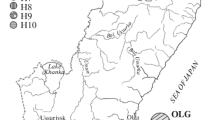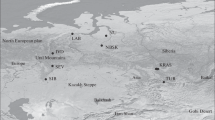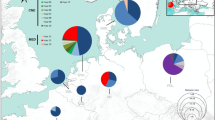Abstract
Genetic variation has been studied in 32 Eastern Siberian and Far Eastern populations of Larix Mill. with the use of three mitochondrial markers based on polymerase chain reaction. Eight multilocus haplotypes with a heterogeneous spatial distribution (G ST = 0.788, N ST = 0.829) have been found, which indicates limited gene flows between populations. Several geographic regions with specific larch haplotype sets have been determined: (1) Japan, (2) southern Sakhalin and the Kuril Islands, (3) Primor’e and Korea, (4) Kamchatka, and (5) Eastern Siberia and the northern Far East. The haplotype fixed in the Kamchatka is absent in the Magadan oblast or Chukotka but is present in southern Primor’e and Sakhalin Island. This may be explained by either the postglacial recolonization of Kamchatka by larch that spread from Primor’e through Sakhalin and the Kuril Islands or its survival through the last glacial maximum in the Kamchatka Peninsula. The biogeography of larch and other woody plants indicate that boreal species have a common history of the colonization of Kamchatka.
Similar content being viewed by others
References
Huntley, B. and Birks, H.J.B., An Atlas of Past and Present Pollen Maps for Europe: 0-13000 Years Ago, Cambridge: Cambridge Univ. Press, 1983.
Willis, K.J. and van Andel, T.H., Trees Or No Trees? The Environments of Central and Eastern Europe during the Last Glaciation, Quat. Sci. Rev., 2004, vol. 23, pp. 2369–2387.
Petit, R.J., Aguinagalde, I., de Beaulieu, J.L., et al., Glacial Refugia: Hotspots but Not Melting Pots of Genetic Diversity, Science, 2003, vol. 300, no. 5625, pp. 1563–1565.
Boyarskaya, T.D., Comparison of Paleoclimate Variation Amplitudes in the Late Pleistocene and Holocene Epochs of Different Regions of the Soviet Union, in Paleoklimaty pozdnelednikov’ya i golotsena (Paleoclimates of the Late Glaciation and Holocene), Moscow: Nauka, 1989, pp. 85–90.
Kremenetskii, K.V., Historical Ranges of the Main Conifers of Siberia in the Holocene, in Korotkoperiodnye i rezkie landshaftno-klimaticheskie izmeneniya za poslednie 15000 let (Short-Term and Sharp Landscape Climatic Changes during the Past 15 000 Years), Moscow: Inst. Geologii Ross. Akad. Nauk, 1994, pp. 160–210.
Sukachev, V.N., On Two More Tree Species Valuable for Forestry, Tr. Lesn. Khoz. Lesn. Prom., 1931, vol. 10, pp. 1–12.
Kolesnikov, B.P., On the Systematics and Developmental History of Larches from the Section Pauciseriales Patcshke, in Materialy po istorii flory i rastitel’nosti SSSR (Materials on the History of the Flora and Vegetation of the Soviet Union), Moscow: Akad. Nauk SSSR, 1946, vol. 2, pp. 321–364.
Dylis, N.V., Listvennitsa Vostochnoi Sibiri i Dal’nego Vostoka (Larches of Eastern Siberia and the Far East), Moscow: Akad. Nauk SSSR, 1961.
Semerikov, V.L., Semerikov, L.F., and Lascoux, M., Intra-and Interspecific Allozyme Variability in Eurasian Larix Mill. Species, Heredity, 1999, vol. 82, pp. 193–204.
Semerikov, V.L. and Lascoux, M., Nuclear and Cytoplasmic Variation within and between Eurasian Larix (Pinaceae) Species, Am. J. Bot., 2003, vol. 90, no. 8, pp. 1113–1123.
Bobrov, E.G., Lesoobrazuyushchie khvoinye SSSR (Forest-Forming Conifers of the Soviet Union), Leningrad: Nauka, 1978.
Palmer, J.D, Mitochondrial DNA in Plant Systematics: Applications and Limitations, in Molecular Systematics of Plants, Soltis, P.S., Soltis, D.E., and Doyle, J.J., Eds., New York: Chapman and Hall, 1992, pp. 36–49.
Iroshnikov, A.I., Geographic Cultures of Conifers in Southern Siberia, in Geograficheskie kul’tury i plantatsii khvoinykh v Sibiri (Geographic Cultures and Plantations of Conifers in Siberia), Manin, E.G. and Iroshnikov, A.I., Eds., Novosibirsk: Nauka, 1977.
Devey, M.E., Bell, J.S., Smith, D.N., et al., A Genetic Linkage Map for Pinus radiata Based on RFLP, RAPD and Microsatellite Markers, Theor. Appl. Genet., 1996, vol. 92, pp. 673–679.
Dumolin-Lapegue, S., Pemonge, M.H., and Petit, R.J., An Enlarged Set of Consensus Primers for the Study of Organelle DNA in Plants, Mol. Ecol., 1997, vol. 6, pp. 393–397.
Semerikov, V.L., Vendramin, G.G., Sebastiani, F., and Lascoux, M., RAPD-Derived, PCR-Based Mitochondrial Markers for Larix Species and Their Usefulness in Phylogeny, Cons. Genet., 2006, vol. 7, no. 4, pp. 621–625.
Schneider, S., Roessli, D., and Excoffier, L., Arlequin Ver. 2.000: A Software for Population Genetics Data Analysis, Univ. Geneva: Genetics and Biometry Laboratory, 2000.
Nei, M., Molecular Evolutionary Genetics, New York: Columbia Univ. Press, 1987.
Pons, O. and Petit, R.J., Measuring and Testing Genetic Differentiation with Ordered versus Unordered Alleles, Genetics, 1996, vol. 144, pp. 1237–1245.
Petit, R.J., Duminil, J., Fineschi, S., et al., Comparative Organization of Chloroplast, Mitochondrial and Nuclear Diversity in Plant Populations, Mol. Ecol., 2005, vol. 14, pp. 689–701.
Jaramillo-Correa, J.P. and Bousquet, J., Mitochondrial Genome Recombination in the Zone of Contact between Two Hybridizing Conifers, Genetics, 2005, vol. 171, no. 4, pp. 1951–1962.
Tarasov, P.E., Volkova, V.S., Webb, T., et al., Last Glacial Maximum Biomes Reconstructed from Pollen and Plant Macrofossil Data from Northern Eurasia, J. Biogeogr., 2000, vol. 27, pp. 609–620.
Spasskaya, I.I., Astakhov, V.I., Glushkova, O.Yu., et al., Razvitie landshaftov i klimata Severnoi Evrazii: Pozdnii pleistotsen-golotsen; elementy prognoza, issue 1: Regional’naya paleogeografiya (Landscape and Climate Development in Northern Eurasia: The Late Pleistocene-Holocene and Elements of Prognosis, issue 1: Regional Palaeogeography), Moscow: Nauka, 1993.
Brubaker, L.B., Anderson, P.M., Edwards, M.E., and Lozhkin, A.V., Beringia as a Glacial Refugium for Boreal Trees and Shrubs: New Perspectives from Mapped Pollen Data, J. Biogeogr., 2005, vol. 32, pp. 833–848.
Fairbanks, R.G., A 17 000-Year Glacio-Eustatic Sea Level Record; Influence of Glacial Melting Rates on the Younger Dryas Event and Deep-Ocean Circulation, Nature, 1989, vol. 342, no. 6250, pp. 637–642.
Adams, R.P. and Pandey, R.N., Analysis of Juniperus communis and Its Varieties Based on DNA Fingerprinting, Biochem. System. Ecol., 2003, vol. 31, pp. 1271–1278.
Author information
Authors and Affiliations
Additional information
Original Russian Text © V.L. Semerikov, M.A. Polezhaeva, 2007, published in Genetika, 2007, vol. 43, No. 6, pp. 789–799.
Rights and permissions
About this article
Cite this article
Semerikov, V.L., Polezhaeva, M.A. Mitochondrial DNA variation pattern in larches of Eastern Siberia and the Far East. Russ J Genet 43, 646–652 (2007). https://doi.org/10.1134/S1022795407060075
Received:
Accepted:
Issue Date:
DOI: https://doi.org/10.1134/S1022795407060075




